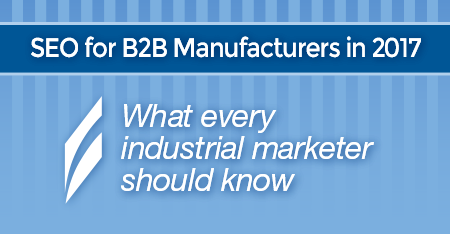Better Content Organization
User experience is a critical factor Google considers when evaluating organic ranking. The clearer and more intuitively structured your information is, the easier it is for Google to index your data and return clearer information to users. One way to help ensure your content is structured successfully is with schema markups – code that you put on your website to help search engines return more informative results. In essence, schema markups tell search engines what your data means, not just what it says.
SEO for B2B Manufacturers – What every industrial marketer should know

Written by Dan Konstantinovsky
Strategic Marketing, RH Blake
![]()
With 71% of B2B customers starting their search for a solution with a generic, non-branded query, Search Engine Optimization has never been more important – Read about the latest key trends you should know about.
Better Content Organization
User experience is a critical factor Google considers when evaluating organic ranking. The clearer and more intuitively structured your information is, the easier it is for Google to index your data and return clearer information to users. One way to help ensure your content is structured successfully is with schema markups – code that you put on your website to help search engines return more informative results. In essence, schema markups tell search engines what your data means, not just what it says.
For example, let’s say the phrase “custom manufacturer” appears on your site. The search engine sees this purely as two words but with the right schema markup around the expression “custom manufacturer,” you can indicate that this is your focus industry, not just a couple of random words.
Do you have relationships with suppliers or distributors? Schema markup enables you to tell Google how one business relates to others.
There are many ways for industrial manufacturers to leverage schema markup in their SEO. To get started, visit Google’s Structured Data Markup Helper.
Enhanced Security
You’ve probably noticed certain websites with the HTTPS designation (HyperText Transfer Protocol Secure). These secure sites typically are ecommerce related or financial institutions, as the added level of security helps with data encryption, authentication and data integrity. But did you know that switching to HTTPS can give a ranking boost to non-ecommerce websites as well?
User and website security is directly linked to user experience – thus it’s to everyone’s benefit to protect privacy by keeping information confidential and secure. If you’re considering making the switch to HTTPS, please visit this excellent article by searchengineland.com.
Voice Search
Traditionally, the first step in Search Engine Optimization programs is identifying relevant keyword phrases and topics. However, in 2017, this initial research shouldn’t just focus on what users are searching for, but rather how they are searching.
According to a recent Google study, over half of U.S. teens and 41% of U.S. adults use voice search on a daily basis, and those percentages are growing. The benefits and attractiveness of voice search are obvious: it’s hands-free, faster and enables multitasking.
So what does this mean for your SEO program? Rather than solely focusing on short tail keywords, content needs to be written in a more conversational tone. Leverage the fact that typically people who type a query and people who ask a question into voice search often have two different search intents. For example, a typer is most likely doing research while the voice searcher is most likely looking for a quick response that will be followed by an action. Content on your website should align with both types of search. Once excellent way to do this is with an FAQ page that answers “who”,”what”, “where”, “when”, “how” and “why” questions in a conversational tone.
User Engagement
Google’s primary goal is to return relevant search results. If they see visitors entering a webpage but either leaving immediately or not navigating further, this signals that the result they clicked on wasn’t extremely relevant. Google then uses this engagement (or lack there of) to update their rankings accordingly. Metrics such as bounce rate, length of time on webpage, number of webpages visited, site speed and actions taken all help Google identify whether your website is relevant for that particular search phrase.
To help enhance user engagement, provide content that directly addresses the searcher’s likely query. Because 43% of people admit to skimming, video is an excellent approach to providing valuable content that is effectively consumed and engaged with (90% of information that comes to the brain is visual and processes 60K times faster than text). For example, including a video on a landing page can increase conversion by 80%. (RH Blake’s Engineered to View™ is a solution to the engagement opportunity).
Free Download: 5 Key Steps to Developing a Digital Marketing Roadmap
A Must Have Digital Marketing Guide for Manufacturers









